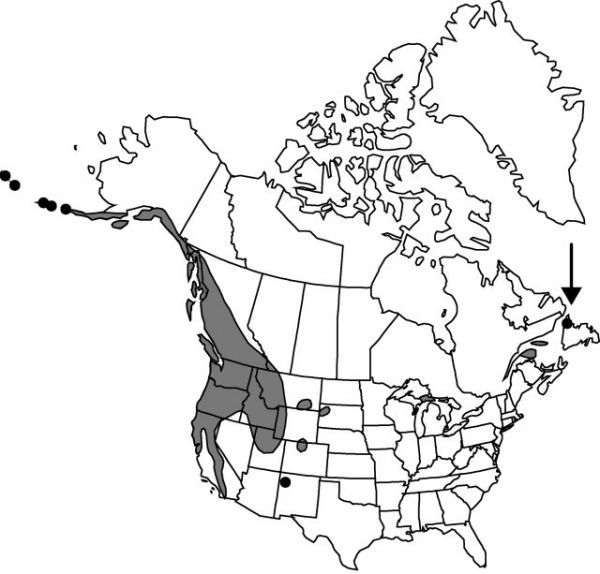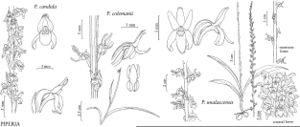Piperia unalascensis
Bull. Torrey Bot. Club 28: 270. 1901.
Plants 9–70 cm. Stems swollen to uniform diameter toward base, 0.7–6.1 mm diam. distal to leaves; bracts 1–8. Leaves prostrate; blade 5–16 (–20) × 1.3–3.5 cm. Inflorescences usually sparsely flowered, 3–44 cm; rachis usually longer than peduncle; bracts 3–23 mm. Flowers ± translucent green, fragrance nocturnal but lingering during day, musky or soapy, sometimes honeylike; sepals ± translucent, 2–4.2 × 1–2.6 mm; dorsal sepal ovate to oblong; lateral sepals spreading to strongly recurved; petals usually projecting to erect, ± straight-sided, asymmetrically ovate to linearlanceolate, 2–5.5 × 0.6–2 mm; lip ± deflexed, broadly ovate to lanceolate-elliptic, 2–5 × 1–3 mm, apex usually somewhat upcurved; spur horizontal to decurved, 2–5.5 mm, ± equal to lip; viscidia broadly elliptic-ovate, 0.15–0.5 × 0.1–0.3 mm; rostellum blunt. Capsules 3.5–10.5 mm. Seeds tan to cinnamon brown.
Phenology: Flowering Jun–Aug; Apr–May, lowlands of n Calif.
Habitat: Coniferous and mixed evergreen forests, generally dry sites, rarely coastal bluffs
Elevation: 0–3000 m
Distribution

Alta., B.C., Nfld. and Labr. (Nfld.), Ont., Que., Alaska, Calif., Colo., Idaho, Mich., Mont., Nev., N.Mex., Oreg., S.Dak., Utah, Wash., Wyo.
Discussion
The racemes in Piperia unalascensis are usually slender and sparsely flowered; racemes of uncommon coastal populations (including the type) are short, stout, and densely flowered. Plants of the coast ranges and the Pacific Northwest are stouter and have broader sepals and petals than do interior and montane forms. Two sympatric forms appear to be in the Sierra Nevada, differing in lip morphology and scent.
Selected References
None.
